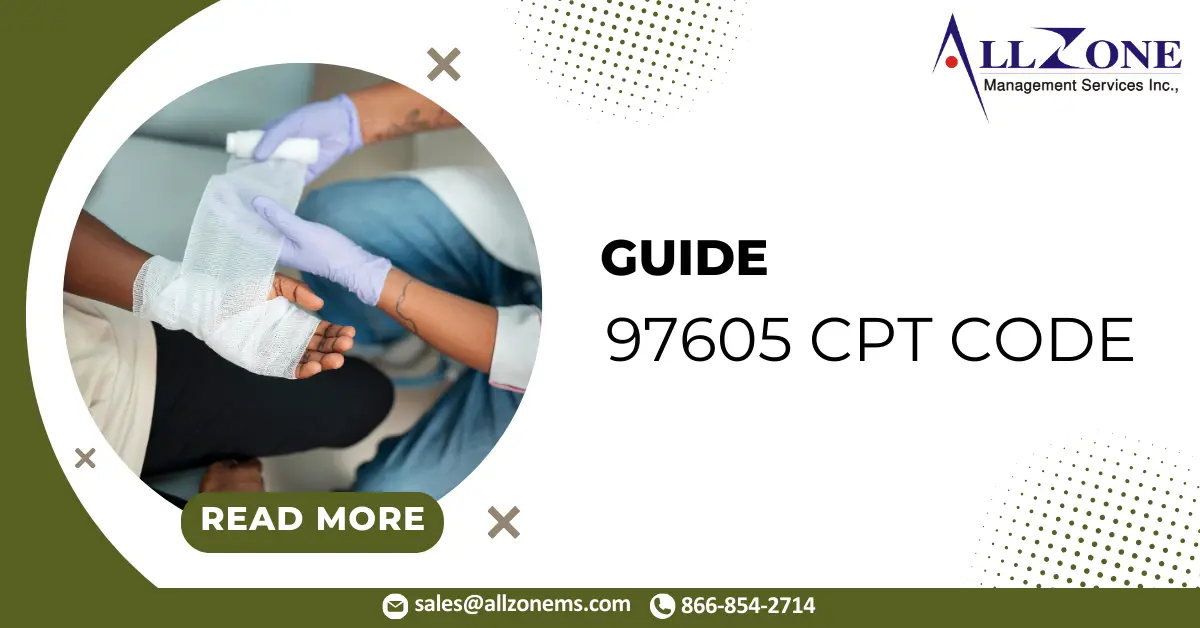CPT code 97605 is the billing code for negative pressure wound therapy (NPWT), a specialized treatment that uses a vacuum-assisted device to promote wound healing. It’s specifically for wounds with a total surface area of 50 square centimeters or less and is used when the therapy utilizes a durable medical equipment (DME) system. This code covers the entire session, including the application of the device, wound assessment, and patient instructions for ongoing care.
Understanding Negative Pressure Wound Therapy (NPWT)
Negative pressure wound therapy (NPWT), often known by brand names like a “wound vac,” is a powerful tool in modern wound care. It works by creating a vacuum over a wound, which helps to remove excess fluids and infectious materials, reduce swelling, and promote blood flow to the area. This process accelerates the formation of granulation tissue, which is the pink, bumpy tissue that forms in a healing wound.
NPWT is typically used for chronic or complex wounds that haven’t responded to traditional treatments. Common conditions treated with NPWT include:
- Diabetic foot ulcers
- Pressure ulcers (bedsores)
- Venous and arterial insufficiency ulcers
- Surgical wound dehiscence
- Traumatic wounds that are left open to heal
The Importance of CPT Code 97605
CPT (Current Procedural Terminology) codes are used by healthcare providers to describe medical, surgical, and diagnostic services to insurance companies for reimbursement. CPT code 97605 is the specific code for NPWT when certain criteria are met. Its primary purpose is to ensure that healthcare providers are accurately compensated for the complex and time-consuming service of applying and managing NPWT.
Accurate billing with CPT 97605 is crucial for a few key reasons:
- Reimbursement: It ensures that providers receive payment for their services.
- Compliance: It helps providers adhere to billing regulations and payer policies.
- Avoiding Denials: Correct coding, along with detailed documentation, reduces the chances of claim denials and payment delays.
Differentiating CPT Codes for NPWT
CPT code 97605 is just one of several codes used for NPWT. It’s vital to choose the correct code to avoid billing errors. The main distinctions are based on the wound size and the type of equipment used.
- CPT Code 97605: Used for NPWT on wounds less than or equal to 50 square centimeters using a durable medical equipment (DME) system. This is a reusable, often electrical, device.
- CPT Code 97606: Used for NPWT on wounds greater than 50 square centimeters using a DME system.
- CPT Code 97607: Used for NPWT on wounds less than or equal to 50 square centimeters using a disposable, non-durable medical equipment system. These are typically smaller, battery-operated units.
- CPT Code 97608: Used for NPWT on wounds greater than 50 square centimeters using a disposable, non-durable medical equipment system.
Billing and Documentation for CPT Code 97605
Successful billing for CPT 97605 hinges on meticulous documentation. Payers, especially Medicare, have strict guidelines to ensure the medical necessity of the treatment.
Essential Documentation Requirements:
- Medical Necessity: The patient’s medical record must clearly justify the need for NPWT, often by showing that other conservative treatments have failed.
- Wound Assessment: Detailed notes are required, including the wound’s location, type, and precise measurements (length, width, depth) before and after the NPWT application.
- NPWT Device Details: Specify the type of equipment used (DME for 97605), the dressing type, and the pressure settings.
- Patient Instructions: Document that the patient received instructions for ongoing care.
- Ongoing Progress: For continued coverage, providers must regularly assess and document the wound’s progress, including changes in dimensions and characteristics.
Common Billing Challenges and Solutions:
- Incorrect Wound Size: A frequent mistake is billing 97605 for a wound larger than 50 cm². Always verify the size and use the correct code (97606) if needed.
- Lack of Documentation: Insufficient wound descriptions or a missing medical necessity justification are prime reasons for claim denials.
- Modifier Misuse: Modifiers, such as -59 (Distinct Procedural Service) or one of the more specific X{EPSU} modifiers, are often necessary when NPWT is performed on the same day as another procedure, like debridement (e.g., CPT codes 11042-11047). These modifiers signal that the NPWT was a separate and distinct service. It’s crucial to consult the National Correct Coding Initiative (NCCI) edits and payer-specific rules.
Conclusion
For healthcare professionals involved in wound care, mastering the nuances of billing is as important as mastering the clinical skills. CPT code 97605 is a cornerstone of this process, representing a specific and valuable service—negative pressure wound therapy for smaller wounds using a durable medical device. By understanding its specific application, the importance of proper documentation, and the distinctions from other related codes, providers can streamline their Medical billing, reduce denials, and ensure they are appropriately reimbursed for the high-quality care they provide. This attention to detail in coding and billing directly supports the financial health of a practice and allows for the continued provision of essential wound care services.

